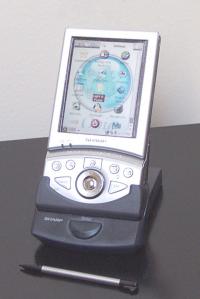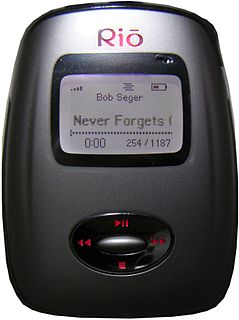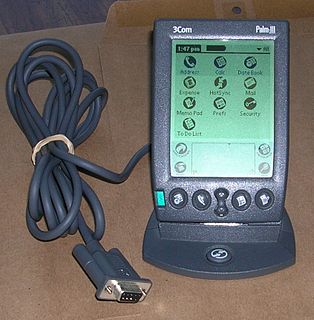A RAM drive is a block of random-access memory that a computer's software is treating as if the memory were a disk drive. It is sometimes referred to as a virtual RAM drive or software RAM drive to distinguish it from a hardware RAM drive that uses separate hardware containing RAM, which is a type of battery-backed solid-state drive.

Palm is an American technology company that developed and designed Personal Digital Assistants (PDAs), mobile phones, and software. Palm devices are often remembered as "the first wildly popular handheld computers," responsible for ushering in the smartphone era. Palm's first PDAs ran the Palm OS, were smaller than competing handhelds, and proved to the industry that there was a market for a new category of portable computing device.

A memory card or memory cartridge is an electronic data storage device used for storing digital information, typically using flash memory. These are commonly used in portable electronic devices, such as digital cameras, mobile phones, computers, tablets, PDAs, portable media players, video game consoles, synthesizers, electronic keyboards and digital pianos.

The Sharp Zaurus is the name of a series of personal digital assistants (PDAs) made by Sharp Corporation. The Zaurus was the most popular PDA during the 1990s in Japan and was based on a proprietary operating system. The first Sharp PDA to use the Linux operating system was the SL-5000D, running the Qtopia-based Embedix Plus. The Linux Documentation Project considers the Zaurus series to be "true Linux PDAs" because their manufacturers install Linux-based operating systems on them by default. The name derives from the common suffix applied to the names of dinosaurs.

CompactFlash (CF) is a flash memory mass storage device used mainly in portable electronic devices. The format was specified and the devices were first manufactured by SanDisk in 1994.

Secure Digital, officially abbreviated as SD, is a proprietary non-volatile memory card format developed by the SD Card Association (SDA) for use in portable devices.
The Zire Series was Palm, Inc's "consumer-grade" brand of Personal Digital Assistant.

A USB flash drive is a data storage device that includes flash memory with an integrated USB interface. It is typically removable, rewritable and much smaller than an optical disc. Most weigh less than 30 g (1 oz). Since first appearing on the market in late 2000, as with virtually all other computer memory devices, storage capacities have risen while prices have dropped. As of March 2016, flash drives with anywhere from 8 to 256 gigabytes (GB) were frequently sold, while 512 GB and 1 terabyte (TB) units were less frequent. As of 2018, 2 TB flash drives were the largest available in terms of storage capacity. Some allow up to 100,000 write/erase cycles, depending on the exact type of memory chip used, and are thought to last between 10 and 100 years under normal circumstances.

The Tungsten series was Palm, Inc.'s line of business-class Palm OS-based PDAs.

A portable media player (PMP) or digital audio player (DAP) is a portable consumer electronics device capable of storing and playing digital media such as audio, images, and video files. The data is typically stored on a CD, DVD, BD, flash memory, microdrive, or hard drive. Most portable media players are equipped with a 3.5 mm headphone jack, which users can plug headphones into, or connect to a boombox or hifi system. In contrast, analogue portable audio players play music from non-digital media that use analogue signal storage, such as cassette tapes or vinyl records.

Microdrive is a registered trademark for miniature, 1-inch hard disks produced by IBM and Hitachi. These rotational media storage devices were designed to fit in CompactFlash (CF) Type II slots. The release of similar drives by other makers led to them often being referred to as "microdrives" too. By 2015, Microdrives were viewed as obsolete, having been overtaken by solid-state flash media in read/write performance, storage capacity, durability, and price.

The Rio Carbon is a line of digital audio players that was produced by the now defunct Rio from 2004 to 2005. It was similar in size, capacity, and cost with Apple's iPod Mini which debuted earlier the same year. This was Rio's second player to use a miniature hard disk for storage, after the Rio Nitrus, which was first to market with a 1.5 GB drive in late 2003.

The Palm TX was a personal digital assistant which was produced by Palm, Inc. It was announced and released as part of Palm's October 2005 product cycle, and was in production until March 2009.

The Palm III is a personal digital assistant that was made by the Palm Computing division of 3Com. It went on sale in 1998 as a replacement for the PalmPilot handheld. It was the first Palm handheld to support infrared file transfer and a Flash ROM-capable operating system. At release, the Palm III was priced at US$400.

The Jornada was a line of personal digital assistants or PDAs manufactured by Hewlett-Packard. The Jornada was a broad product line that included Palm-Size PCs, Handheld PCs, and Pocket PCs. The first model was the 820, released in 1998, and the last was the 928 model in 2002 when Compaq and HP merged. The Jornada line was then succeeded by the more popular iPAQ model PDAs. All Jornada models ran Microsoft Operating Systems that were based on Windows CE.

The Samsung Q1 was a family of Ultra-Mobile PCs produced by Samsung with a 7" (18 cm) LCD and exists in several different versions with either Windows XP Tablet PC Edition or Windows Vista Home Premium

The Pepper Pad was a family of Linux-based mobile computers with Internet capability and which doubled as a handheld game console. They also served as a portable multimedia device. The devices used Bluetooth and Wi-Fi technologies for Internet connection. Pepper Pads are now obsolete, unsupported and the parent company has ceased operations.

The Nokia N800 Internet tablet is a wireless Internet appliance from Nokia, originally announced at the Las Vegas CES 2007 Summit in January 2007. N800 allows the user to browse the Internet and communicate using Wi-Fi networks or with mobile phone via Bluetooth. The N800 was developed as the successor to the Nokia 770. It includes FM and Internet radio, an RSS news reader, image viewer and a media player for audio and video files.

Read-only memory (ROM) is a type of non-volatile memory used in computers and other electronic devices. Data stored in ROM cannot be electronically modified after the manufacture of the memory device. Read-only memory is useful for storing software that is rarely changed during the life of the system, also known as firmware. Software applications for programmable devices can be distributed as plug-in cartridges containing read-only memory.
The HTC Evo Shift 4G is a smartphone developed by HTC Corporation and marketed as the concurrent/sequel to Sprint's flagship Android smartphone, running on its 4G WiMAX network. The smartphone launched on January 9, 2011.

















